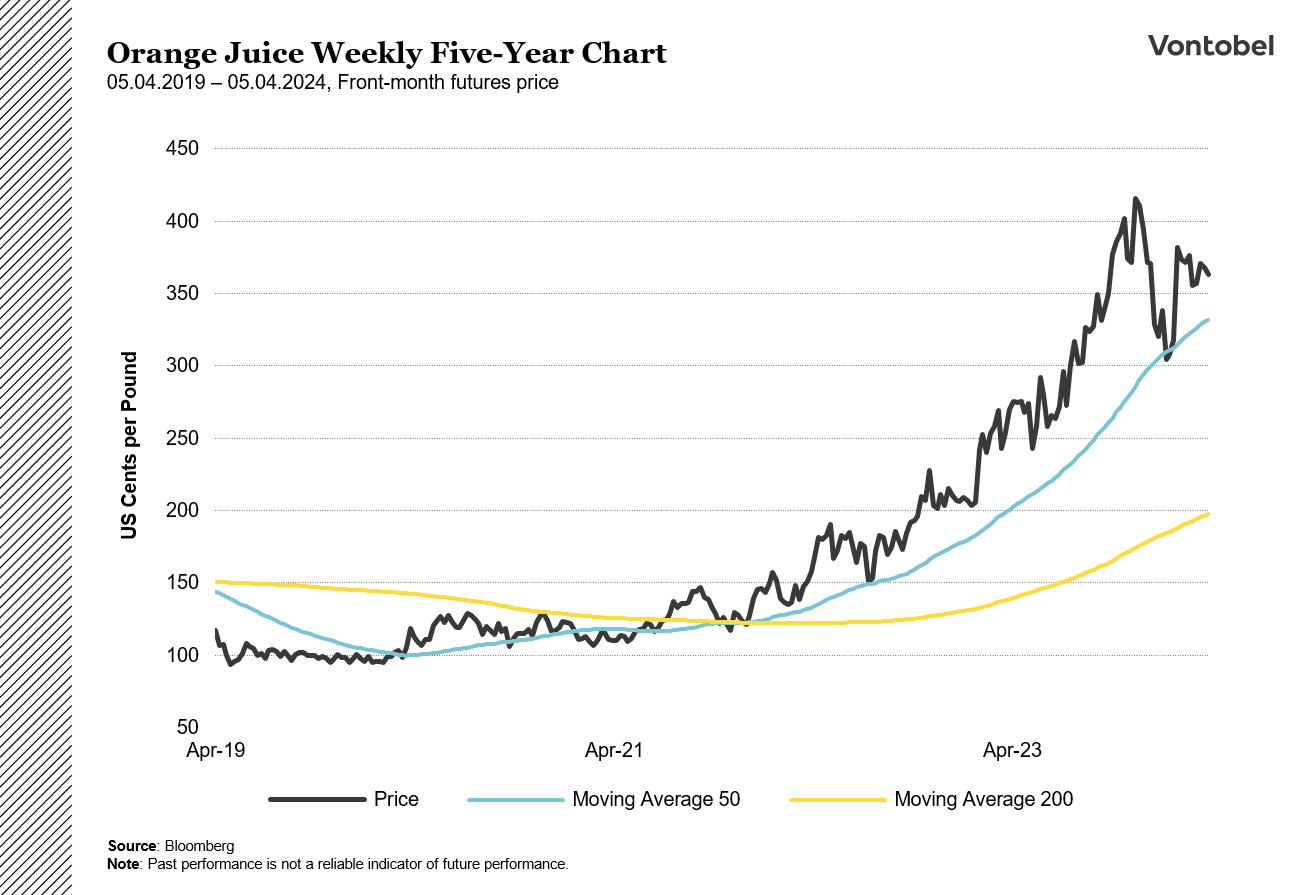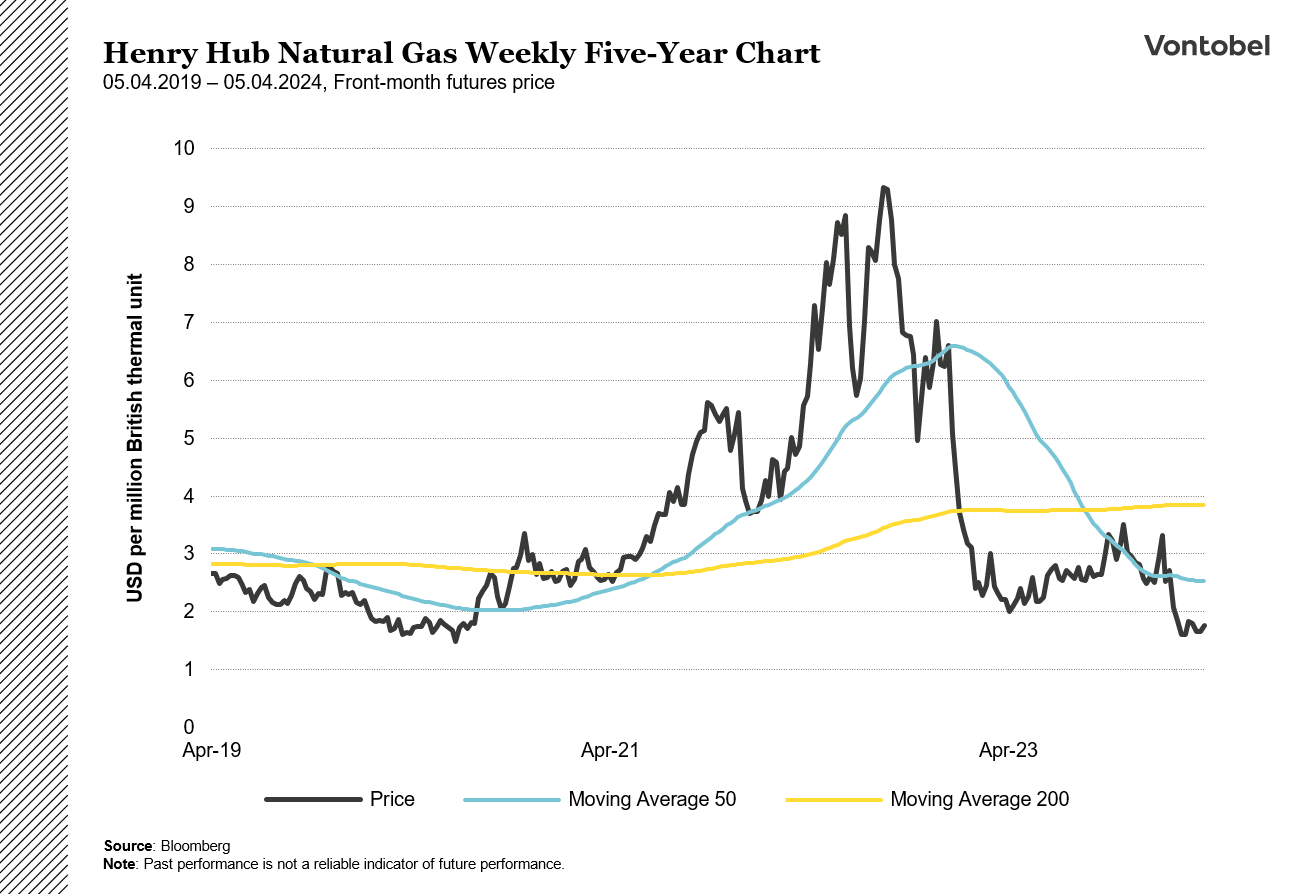Vontobel Commodity Insight

As usual, there has been a lot going on in the commodity market recently. Plant diseases have affected agriculture and the weather has affected the energy market, causing prices to rise and fall. This week three commodities with strong price movements are highlighted: cocoa, orange juice and natural gas.
Cocoa - the Bitcoin of commodities?
Cocoa does not share many similarities with the cryptocurrency Bitcoin. It does not have a fancy blockchain, is not a means of payment and does not retain its value very well over time. In fact, the assets are very different from each other, except for one characteristic: price performance. If you were to look at the price performance of the assets in 2023 and 2024, you wouldn't know which one belonged to which. Both have had an exponential development in 2023 and so far in 2024.
Unlike Bitcoin, cocoa is not digitally mined by high-performance computers, the process is more analogue. Cocoa beans grow on cocoa trees with the Latin name Theobroma cacao and are the main ingredient in chocolate. Cocoa cultivation is mainly found in West Africa, with Côte d'Ivoire and Ghana being the two largest producers according to the Food and Agriculture Organisation Corporate Statistical Database (FAOSTAT). These countries accounted for over 50% of world production in 2018, exceeding 5.2 million tonnes of cocoa beans.
The reason behind the price explosion is weather conditions and disease. Extreme heat and heavy rainfall have helped spread diseases such as black pod disease and swollen shoot virus, two diseases that have hampered this year's harvests. According to Bloomberg, the poor conditions are expected to reduce harvests by 25 and 35 per cent in Ivory Coast and Ghana respectively. Certainly a significant impact on supply, and an explanation behind why the price graph looks the way it does.
Looking at the three-month chart with daily intervals, the cocoa price is trading above both the Moving Average (MA) 50 and 200. The price movement during this period has been 133 per cent over the time period of the graph.

Moving on to a five-year horizon, the cocoa price has developed 306 per cent over the time period of the graph. The majority of this rise has come during 2023 onwards, a parabolic movement.

Has the last drop been squeezed?
Orange juice, or more formally frozen concentrated orange juice, was the best performing commodity of 2023. Like the cocoa crop, the orange counterpart was also hit hard by disease last year. Yellow dragon disease ravaged the plantations, causing havoc for growers who saw their harvest suffer. The bacterium behind the disease, Candidatus liberibacter asiaticus, is spread by the Asian citrus psyllid, and degrades the orange trees until they eventually die. The disease, coupled with poor weather conditions, led to a significant drop in production and a surge in prices.
The disease was previously labelled as incurable, which is still the case, but hope for a cure has grown. According to the research agency Agricultural Research Service (ARS), part of the US Department of Agriculture (USDA), scientists may have found a solution. By genetically modifying orange trees and incorporating genes from other plants that naturally repel the bacteria, the trees can resist the disease. Further research in this area is expected in the coming years. The discovery is positive news for orange growers, potentially bringing production back to normal levels and thus reducing orange juice prices in the long term.
The three-month graph shows that the momentum has slowed down. In recent months, the price of orange juice has traded in a range between 365 - 385 US cents per pound.

Looking at the five-year chart, orange juice is trading in a strong uptrend, with the price above both the MA50 and MA200. However, the sharp rise has slowed down in 2024.

Bears enjoying the warmth of spring
Spring is here. The sun has started to shine and the trees are blooming. We have now entered one of many people's favourite seasons, which is off to a great start. The unusually warm weather in the United States has caused the demand for energy to take a beating.
Natural gas, which is used for heating and other purposes, has seen its price fall sharply as a result. The price of natural gas (Henry Hub) is trading near a five-year low, and has fallen sharply since its peak in 2022 when the cold dominated and the war in Ukraine was just beginning. The Henry Hub price is now below USD 2 per million British thermal units until 8 April 2023, a bargain in the eyes of consumers who not long ago were paying over USD 9.

An important factor to keep in mind going forward is the weather. Of course, if the warm weather continues, it could benefit those hoping for low energy prices. According to the US Climate Prediction Center, part of the National Oceanic and Atmospheric Administration, the weather is expected to be warmer than usual in April.
The five-year chart reflects this picture, showing that the price has fallen sharply. Henry Hub is trading below both MA50 and MA200, a negative trend for the commodity.

Will the price of Henry Hub continue to fall? Or have we seen a bottom? Regardless of your market believes you can find our products HERE.
Risks
Disclaimer:
This information is neither an investment advice nor an investment or investment strategy recommendation, but advertisement. The complete information on the trading products (securities) mentioned herein, in particular the structure and risks associated with an investment, are described in the base prospectus, together with any supplements, as well as the final terms. The base prospectus and final terms constitute the solely binding sales documents for the securities and are available under the product links. It is recommended that potential investors read these documents before making any investment decision. The documents and the key information document are published on the website of the issuer, Vontobel Financial Products GmbH, Bockenheimer Landstrasse 24, 60323 Frankfurt am Main, Germany, on prospectus.vontobel.com and are available from the issuer free of charge. The approval of the prospectus should not be understood as an endorsement of the securities. The securities are products that are not simple and may be difficult to understand. This information includes or relates to figures of past performance. Past performance is not a reliable indicator of future performance.
© Bank Vontobel Europe AG and/or its affiliates. All rights reserved.
Credit risk of the issuer:
Investors in the products are exposed to the risk that the Issuer or the Guarantor may not be able to meet its obligations under the products. A total loss of the invested capital is possible. The products are not subject to any deposit protection.
Market risk:
The value of the products can fall significantly below the purchase price due to changes in market factors, especially if the value of the underlying asset falls. The products are not capital-protected
Risk with leverage products:
Due to the leverage effect, there is an increased risk of loss (risk of total loss) with leverage products, e.g. Bull & Bear Certificates, Warrants and Mini Futures.
Product costs:
Product and possible financing costs reduce the value of the products.
Currency risk:
If the product currency differs from the currency of the underlying asset, the value of a product will also depend on the exchange rate between the respective currencies. As a result, the value of a product can fluctuate significantly.
